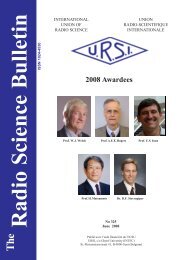Radio Science Bulletin 313 - June 2005 - URSI
Radio Science Bulletin 313 - June 2005 - URSI
Radio Science Bulletin 313 - June 2005 - URSI
- No tags were found...
Create successful ePaper yourself
Turn your PDF publications into a flip-book with our unique Google optimized e-Paper software.
differences and goals of these classification schemes, moreunified categorization criteria, which may suit therequirements of some technical communities (radar,communication, electromagnetic interaction, directedenergy), have been proposed for real-valued causal signalsby partially merging the definitions and criteria of the threeschemes. The new categorization criteria are formed bytaking the OSD/DARPA criteria as the kernel and byrealigning the OSD/DARPA ranges for Wideband andUWB to match the IEC scheme, with a couple ofmodifications to IEC thresholds. The Mesoband regime isreduced to agree with the OSD/DARPA Widebanddesignation ( 0.01 < B F ≤ 0.25 ); the UWB regime is splitinto Sub-Hyperband ( 0.25 < B F ≤ 1.50 ) and Hyperband(1.50 < < 2.00 ).B FThe second component of creating a viableclassification scheme is appropriately defining bandwidth.Many of the inconsistencies inherent in the threeclassification schemes and the associated challenges havebeen illustrated by applying six of the many bandwidthdefinitions in the literature to four ideal test signals, and bycomparing the results. Since the signals under considerationare real-valued, these bandwidths are defined for nonnegativefrequencies only, and fall into three classes: power-levelbased ( B 3dB , B 10dB , B 20dB ); energy based ( B 90EB ,B 99EB ); and moment based ( B RMS ). When the parametersof the four signals are chosen so that they are consideredUWB in some sense, only the impulse-like signal (Gaussian)is uniquely classified (Hyperband UWB) for all sixbandwidths under the new categorization criteria. In contrast,the exponentially damped five-cycle sine has the widestvariety of classifications: Wideband by B 3dB ; Sub-Hyperband UWB by B 10dB and B 90EB ; and HyperbandUWB by B 20dB , B RMS , and B 99EB . On averaging over thesix bandwidths, the signals in order of decreasing spectralwidth are: Gaussian (most broadband); single-cycle sine;exponentially damped five-cycle sine; and linear frequencymodulated(least broadband). Although some pros and consof these six bandwidth definitions have been discussed, noconclusion on whether one bandwidth definition is preferableover the others has been reached. This begs the question ofwhether using additional parameters would permit a uniqueclassification of real causal signals across all bandwidthdefinitions.Even if additional parameters are not useful inproviding a unique signal classification over the variousbandwidth measures, they certainly could be useful forevaluating devices. For example, phase plays an importantrole in describing and characterizing devices. Consequently,quantifying how closely the phase and magnitude of adevice’s transfer function approximate constant and linearfunctions, respectively, will indicate how accurately thedevice replicates its input signal.Although the authors feel that the proposedcategorization criteria offer a good compromise to existingcriteria (OSD/DARPA, IEC, FCC), the new classificationscheme is incomplete because a bandwidth definition hasnot been selected. This is the more difficult aspect ofspecifying a useful, unambiguous, and possibly broadclassification scheme. It may well be that a new classificationscheme must include several definitions of bandwidth, ormay have to be sufficiently vague to permit broadinterpretation. In any case, additional investigations ofother bandwidth definitions are needed before resolvingwhether a new classification scheme is possible. Given theopen questions associated with spectrally based classificationschemes for signals and devices, one should exercise greatcare in attempting to define terms like UWB radar.8. References1. OSD/DARPA, Ultra-Wideband Radar Review Panel, “Assessmentof Ultra Wide-Band (UWB) Technology,” Arlington,VA, Defense Advanced Research Project Agency (DARPA),1990.2. US Federal Communications Commission (FCC), Part 15,October 2003, http://www.fcc.gov/oet/info/rules.3. International Electrotechnical Commission (IEC), Basic EMCPublication 61000-2-13: “Environment – High-power Electromagnetic(HPEM) Environment – Radiated and Conducted.”4. W. M. Manheimer, A. W. Fliflet, K. St. Germain, G. J. Linde,W. J. Cheung, V. Gregers-Hansen, B. G. Danly, and M. T.Ngo, “Initial Cloud Images with the NRL High Power 94 GHzWARLOC Radar,” Geophysical Research Letters, 30, 3, February4, 2003, pp. 3-1–3-4.5. R. A. Scholtz, “How Do You Define Bandwidth?” Proceedingsof the International Telemetering Conference, Los AngelesCA, October 1972, pp. 281-288.6. American National Standards Institute (ANSI), ANSI C63.14-1998, American National Standards Dictionary for Technologiesof Electromagnetic Compatibility (EMC), ElectromagneticPulse (EMP), and Electromagnetic Discharge (ESD),October 1998.7. D. V. Giri and F. M. Tesche, “Classification of IntentionalElectromagnetic Environments (IEME),” IEEE Transactionson Electromagnetic Compatibility, 46, 3, August 2004, pp.322-328.8. Institute of Electrical and Electronics Engineers (IEEE), IEEEStd 145-1993, IEEE Standard Definitions of Terms for Antennas,March 1993.9. A. W. Rihaczek, Principles of High-Resolution Radar, NewYork, McGraw-Hill, 1969, Ch. 2, pp. 10-40.10.Institute of Electrical and Electronics Engineers (IEEE), IEEEStd 686-1997, IEEE Standard Radar Definitions, 16 September1997.11.S. N. Samaddar and E. L. Mokole, “Some Basic Properties ofAntennas Associated with Ultrawideband Radiation,” in C.E.Baum, L. Carin, and A.P. Stone (eds.), Ultra-Wideband,Short-Pulse Electromagnetics 3, New York, New York, PlenumPress, 1997, pp. 147-164.12.Manual of Regulations and Procedures for Federal <strong>Radio</strong>Frequency Management, National Telecommunication andInformation Administration, May 2003 (rev. September 2004).13.M. I. Skolnik, Introduction to Radar Systems, Third Edition,New York, McGraw-Hill, 2001, pp. 341-349.14.C. E. Cook, “Pulse Compression – Key to More EfficientRadar Transmission,” Proc. IRE, 48, March 1960, pp. 310-316.15.D. Lamensdorf and L. Susman, “Baseband-Pulse-AntennaTechniques,” IEEE Antennas and Propagation Magazine, 36,1, 1994, pp. 20-30.26The<strong>Radio</strong> <strong>Science</strong> <strong>Bulletin</strong> No <strong>313</strong> (<strong>June</strong>, <strong>2005</strong>)
















